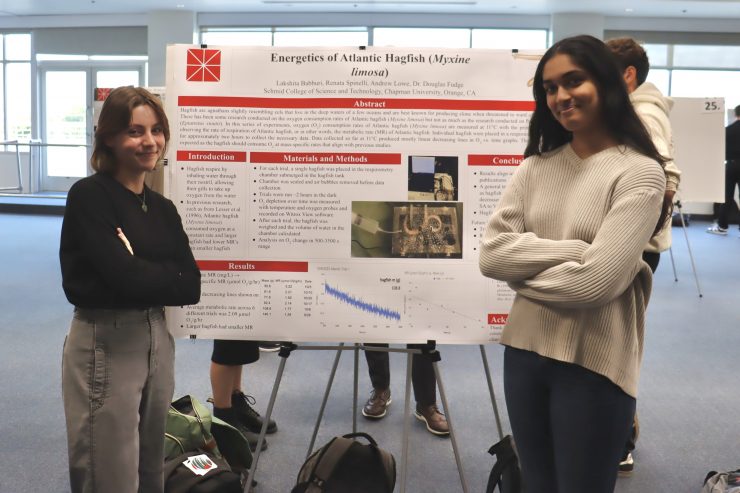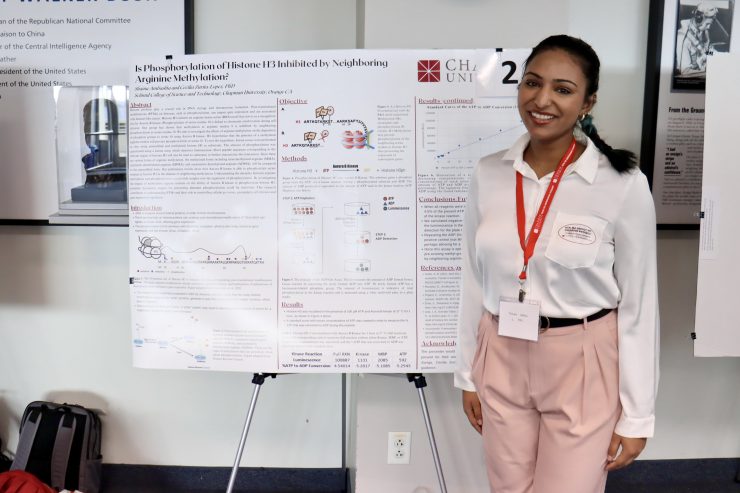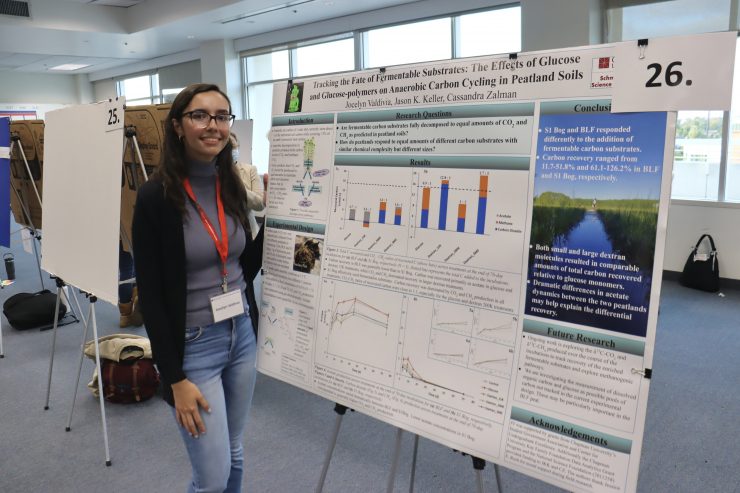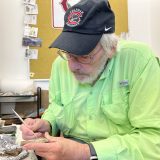Schmid Students Present Research at Student Scholar Symposium "Doing research had a huge impact on my confidence as a scientist," said Paul Rosa '24
December 4, 2023
On Wednesday, November 29, Chapman’s Center for Undergraduate Excellence (CUE) hosted the biannual Student Scholar Symposium, which celebrates the breadth and depth of scholarly research and creative exploration by Chapman students. Projects ranged across all academic and creative disciplines. 36 Schmid students presented research posters, reflecting the college’s culture of rigorous inquiry.
“The Student Scholar Symposium is education in action, a true example that Chapman students are pursuing anything imaginable,” said CUE Director Julye Bidmead.
Please enjoy this sampling of research presented by Schmidsters:

Keon Jafari ’25: Cell Surface Receptors for Targeting Radiotherapy to Cancer Sites and Other Applications
Advisor: Professor Kamaljit Kaur, School of Pharmacy
Abstract: Cell surface receptors have emerged as versatile molecular targets for a wide range of biomedical applications, including radiotherapy targeting, drug delivery, and diagnostic imaging. A particular spotlight shined upon Prostate-Specific Membrane Antigen (PSMA) and Somatostatin receptors highlights these receptors’ significance in radiotherapy targeting and their applications in precision medicine. The intricate molecular mechanisms underpinning these receptors, their exploitation in therapeutic strategies, and their expanding roles in diverse medical applications were examined. Radionuclide Therapy effectiveness using peptides, that target radionuclide to cancer site, has gained attention due to the recent FDA approval of two peptide-radionuclide therapy conjugates and one in phase II clinical trials. For instance, Lutetium 177 DOTA TATE, and PEN-211 have been explored, as well as their molecular contexts in treating and visualizing tumors with high Somatostatin receptor (SSTR2) expression. Nonetheless, this overview underscores the imperative need for interdisciplinary collaboration to fully unlock the potential of cell surface receptors for multifaceted medical applications.
Jafari worked in Associate Professor Marco Bisoffi’s lab last year, and after expressing interest in clinical research, Bisoffi referred him to Professor Kamaljit Kaur. “She has a long background in drug research development, and we get to work one-on-one. I’m really happy with the research I’ve done. I’m learning so much,” he said.
Jafari, a Biological Sciences major and Psychology minor, hopes to become a physician, but this research has caused him to consider pursuing radiology or oncology. His research is currently in the process of publication.

Paul Rosa ’24: Comparative Analysis of +2 Oxidation State Metal Lewis Acids in Sulfur(VI) Fluoride-Amine Coupling Reactions
Advisor: Assistant Professor Maduka Ogba, Schmid College of Science and Technology
Abstract: We investigate how the nature of the metal ion affects the capacity of Lewis acidic salts to act as catalysts in metal-mediated sulfur(VI) fluoride exchange (SuFEx). Previous reports suggest that calcium bistriflimide Ca(NTf2)2 promotes efficient coupling of sulfur(VI) fluorides to amines. However, a systematic investigation into ion-pair effects in promoting sulfur(VI) fluoride activation has not been reported. Therefore, we lack mechanistic data that enables rational experimental redesign to improve reaction efficiency. In this work, we present a computational analysis of the likely SuFEx mechanism and activation mode mediated by zinc bistriflimide Zn(NTf2)2. We hypothesize that Ca(NTf2)2 is more effective than Zn(NTf2)2 due to its larger atomic radius, thus allowing better accommodation of the key salt-substrate interactions that promote SuFEx. We compare our findings to previously reported work with Ca(NTf2)2. Our results lend insights into how steric and electronic factors affect the Lewis acid reactivity of group II salts, and their capacity to facilitate the activation of fluorinated compounds.
“Doing research had a huge impact on my confidence as a scientist,” said Rosa. “It helped me solidify what I was learning in class — it gave me a way to apply it in a project. Doing research is not always about what you’re studying, it’s about learning the process. It’s its own art.”
Rosa will graduate this Spring with a major in Biological Sciences and a minor in Philosophy. In addition, he is part of the selective Beckman Scholars program at Schmid. He plans to pursue a doctoral degree in biochemistry after graduation.

Lakshita Babburi ’26 and Renata Spinelli ’25: Energetics of Atlantic Hagfish
Advisor: Professor Douglas Fudge, Schmid College of Science and Technology
Abstract: Hagfish are agnathans slightly resembling eels that live in the deep waters of a few oceans and are best known for producing slime when threatened to ward off predators. There has been some research conducted on the oxygen consumption rates of Atlantic hagfish (Myxine limosa) but not as much as the research conducted on Pacific hagfish (Eptatretus stoutii). In this series of experiments, oxygen (O2) consumption rates of Atlantic hagfish (Myxine limosa) are measured at 11°C with the primary focus of observing the rate of respiration of Atlantic hagfish, or in other words, the metabolic rate (MR) of Atlantic hagfish. Individual hagfish were placed in a respirometry chamber for approximately two hours to collect the necessary data. Data collected so far at 11°C produced mostly linear decreasing lines in O2 vs. time graphs. These results are expected as the hagfish should consume O2 at mass-specific rates that align with previous studies.
Spinelli appreciates that research provides an opportunity for exploration outside of the classroom. “There’s no correct answer,” said Spinelli. “It’s just about adding information to the literature, which makes it really interesting.”

Kyle Choy ’24 and Anne Marie Santich ’24: Development of Colloid-Collagen Composites for Bioengineering Applications
Advisor: Professor Andrew Lyon, Fowler School of Engineering Founding Dean
Abstract: Extracellular matrix-derived materials have been demonstrated to be an extremely important class of materials for bioengineering applications such as tissue scaffolding. Collagen is a particularly excellent example of this due to its biocompatibility and biodegradability. However, collagen’s utility in applications has been frequently limited by the weak mechanical strength of 3D gels prepared from the material. To circumvent this limitation, we are studying the incorporation of microgels in collagen composites for mechanical reinforcement. Our group’s development of ultra-low crosslinked poly(N-isopropylacrylamide) microgels has enabled this work, as the incorporation of these microgels increases the mechanical strength of the collagen composites showing great potential for bioengineering applications. Previous research done by the Lyon group showed that incorporation of microgels in collagen composites and varying micogel concentrations during development resulted in seamless integration of the microgel into the composites. Building on that research, we have successfully developed a methodology to create highly packed colloid-collagen composites with different amounts of collagen using colloidal “pastes” developed in our lab. With the use of optical microscopy, we observed and characterized these colloid-collagen composites. Even when using highly packed, rigid pastes, collagen is able to grow 3D networks that integrate into the paste, presumably due to the low shear stress required to displace the microgels. The next steps in our research are to conduct more studies on the colloidal paste to do rheology modifications of extracellular matrix-based materials, notably collagen. To accomplish this, we will conduct experiments including real-time imaging of collagen formation using optical microscopy. This will allow us to see the integration of the microgels while the collagen grows which will help us better characterize these composites that are the next step in advancing bioengineering applications.
Choy initially began working in Professor Andrew Lyon’s lab as a literature reviewer, but as he progressed, he began working on experimental work. Choy will graduate this Spring with majors in both Biochemistry and Molecular Biology, as well as a minor in Health Sciences. Choy plans to pursue graduate or medical school after graduating.

Shaina Ambashta ’25: Is Phosphorylation of Histone H3 Inhibited by Neighboring Arginine Methylation?
Advisor: Assistant Professor Cecilia Lopez, Schmid College of Science and Technology
Abstract: Histone proteins play a crucial role in DNA storage and chromosome formation. Post-translational modifications (PTMs) on histones, such as phosphorylation, can impact gene expression and are associated with diseases like cancer. Histone H3 contains an arginine-lysine-serine (RKS) motif that serves as a recognition site for Aurora B kinase. Phosphorylation of serine residue 10 is linked to chromatin condensation during cell division. Our group has shown that methylation at arginine residue 8 is inhibited by neighboring phosphorylation at serine residue 10. We aim to investigate the effects of arginine methylation on the deposition of phosphate groups to serine 10 using Aurora B kinase. We hypothesize that the presence of a methylated arginine residue will prevent phosphorylation at serine 10. To test this hypothesis, kinase assays were performed in vitro using unmodified and methylated histone H3 as substrates. The amount of phosphorylation was quantitated using a kinase assay which measures luminescence. Short peptide sequences corresponding to the relevant region of histone H3 will also be used as substrates to further characterize this interaction. Since there are various forms of arginine methylation, the methylated forms including monomethylated arginine (MMA), symmetric dimethylated arginine (SDMA), and asymmetric dimethylated arginine (ADMA), will be compared to the unmodified form. Our preliminary results show that Aurora B kinase is able to phosphorylate serine residues in histone H3 in the absence of neighboring methylation. Understanding the interplay between arginine methylation and phosphorylation can provide insights into the regulation of phosphorylation. By investigating the impact of methylated arginine residues on the ability of Aurora B kinase to phosphorylate histone H3, potential therapeutic targets for preventing aberrant phosphorylation could be identified. This research contributes to understandingPTMs and their role in controlling cellular processes, particularly cell division and gene expression regulation.
Ambashta is pursuing majors in Biochemistry and Molecular Biology as well as a minor in Computer Science. Her interest in this research began when Professor Cecilia Lopez gave a talk in her introductory biochemistry course. “During that talk, something she said stuck out to me,” said Ambashta. “She said that medicine is not the only way we can save lives — we can also save lives through research.” After the class, Ambashta reached out to Lopez and expressed interest in joining her lab.
“Dr. Lopez is amazing, and she’s connected me to so many opportunities,” said Ambashta, who recently received a SURF fellowship for summer research.

Jocelyn Valdivia ’24: Tracking the Fate of Fermentable Substrates: the Effects of Glucose and Glucose-polymers on Anaerobic Carbon Cycling in Peatland Soils
Advisors: Professor Jason Keller and Associate Professor Cassandra Zalman
Abstract: Understanding the amount of carbon dioxide (CO2) and methane (CH4) produced by microbial anaerobic decomposition within peatlands is key for understanding peatland-climate feedbacks. In theory, the anaerobic microbial decomposition of fermentable substrates (e.g., glucose) should produce a 1:1 ratio of CO2:CH4 to achieve both carbon and charge balance. However, this ratio is rarely seen in peatland soils for reasons which are not fully understood. In this study, we anaerobically collected surface soil from two Sphagnum-dominated peatlands in northern Minnesota and amended them with either glucose or dextran (a glucose polymer) of three different molecular weights. All treatments contained the same amount of carbon. Following the carbon substrate addition, the soils were anaerobically incubated at 15 degrees Celsius. Concentrations and delta 13C of CO2 and CH4 as well as dissolved concentrations of acetate (and other low molecular weight organic compounds) were measured periodically. After four weeks of incubation, the first soil had a 0-15% recovery of the added carbon in the form of greenhouse gasses. This excess recovered carbon resulted in a CO2:CH4 ratio ranging from 2.4:1 to 5.5:1 for amended soils in comparison to the control treatment with a 1.7:1 ratio. The second soil resulted in a 29-45% recovery of the added carbon in the form of greenhouse gasses. The CO2:CH4 ratio of recovered substrates was more constrained, and closer to the theoretical value, it ranged from 1.1:1 to 1.8:1 while the control treatment resulted in a 1.0:1 ratio. In the second soil, larger dextran molecules had higher percent recovery and higher CO2:CH4 ratios. Results to date highlight that fermentable substrates with similar chemical composition are decomposed differently in peatland soils.
Valdivia enjoys the balance in her research between empirical and statistical work. “I’m doing a lot of hands-on work, but at the end of my experiments, I have to analyze the data in Excel. It’s a nice mixture.”
Valdivia worked with Professor Jason Keller and Associate Professor Cassandra Zalman on this research, which she has been involved with since her first year at Schmid. “Professors are very welcoming here,” said Valdivia. “This research revolves around chemistry, geology, and a little bit of bio — it is a blend of things I’m interested in.”


